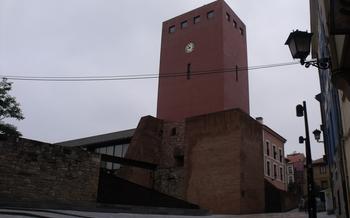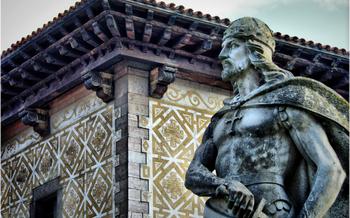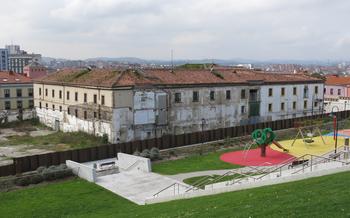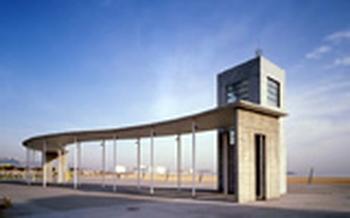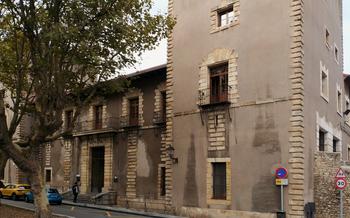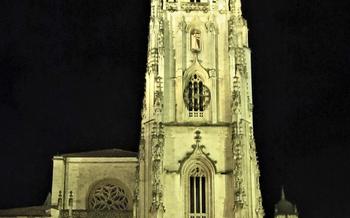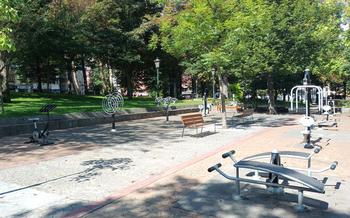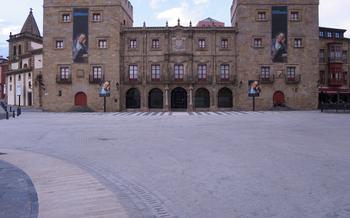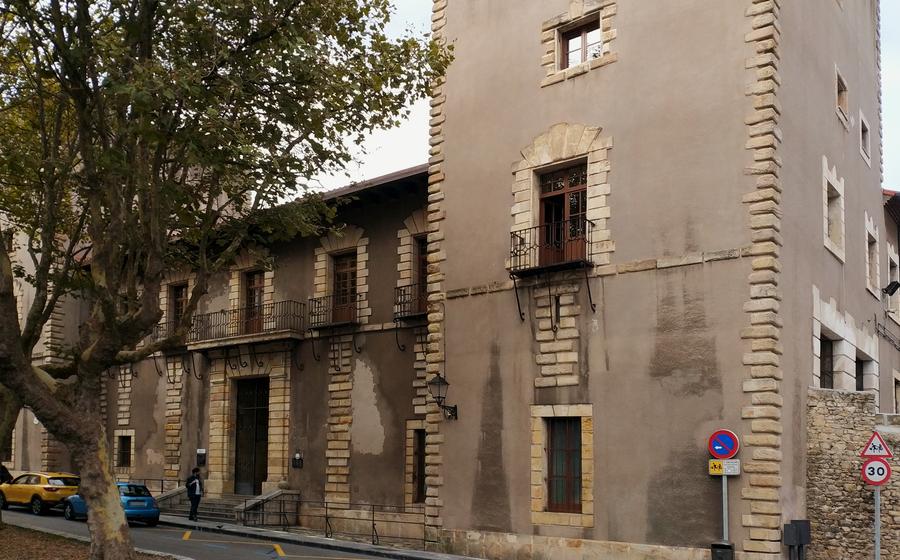
The Asturian Ethnographic Museum
- The Asturian Ethnographic Museum: A Journey Through Asturian Culture
- Exploring the Museum's Enchanting Collection:
- Interactive Exhibits for an Immersive Experience
- Discover the Wonders of the Asturian Village:
- Delving into Asturian Traditions and Festivals
- Traditional Craftsmanship: A Legacy Preserved
- Maritime Heritage: A Connection to the Sea
- A Culinary Journey Through Asturian Cuisine
- Storytelling Through Traditional Asturian Legends
- Temporary Exhibitions: A Window to Contemporary Culture
- Museum Shop: A Treasure Trove of Asturian Crafts
- Educational Programs: Engaging with the Past
- Accessibility and Inclusivity
- Insider Tip: Uncovering Hidden Gems
The Asturian Ethnographic Museum: A Journey Through Asturian Culture
The Asturian Ethnographic Museum, a captivating cultural institution nestled in the vibrant city of Gijón, serves as a gateway to understanding the rich heritage and traditions of the Asturias region in Spain. Founded in 1968, the museum is housed in a beautifully restored 18th-century palace, providing a majestic backdrop to its diverse collection. With a mission to preserve and showcase the unique identity of Asturias, the museum offers an immersive journey into the region's past and present, inviting visitors to delve into the captivating world of Asturian culture.
Located in the heart of the city, the Asturian Ethnographic Museum is easily accessible by foot, public transportation, or car. Its central location makes it an ideal starting point for exploring Gijón's other cultural attractions, such as the Gijón Aquarium and the Jovellanos Museum. The museum's convenient accessibility ensures that visitors of all abilities can conveniently immerse themselves in the cultural treasures of Asturias.
The Asturian Ethnographic Museum plays a crucial role in safeguarding and promoting the cultural legacy of the region. Through its extensive collection, educational programs, and community outreach initiatives, the museum actively works to preserve traditional Asturian customs, crafts, and livelihoods. By fostering a deep appreciation for the region's unique heritage, the museum contributes to the cultural identity and sense of pride among Asturians and visitors alike.
In addition to its role in preserving cultural heritage, the Asturian Ethnographic Museum offers a truly unique and engaging experience for visitors. With its interactive exhibits, immersive storytelling, and hands-on activities, the museum brings history to life, creating a lasting impression on visitors of all ages. Whether you're a history buff, a culture enthusiast, or simply looking for a captivating day out, the Asturian Ethnographic Museum promises an unforgettable journey through the heart of Asturias.
Exploring the Museum's Enchanting Collection:
As you wander through the museum's galleries, you'll be captivated by the diverse range of artifacts that showcase the essence of Asturian life. Traditional costumes, intricately embroidered and adorned with vibrant colors, tell stories of regional identity and craftsmanship. Tools and everyday objects, from simple farming implements to ornate household items, provide a glimpse into the daily routines and livelihoods of past generations.
Through these artifacts, you'll gain insights into rural and maritime livelihoods, the two pillars of Asturian culture. Discover the ingenious techniques used by farmers to cultivate crops in the rugged terrain, and learn about the bravery and skill of the fishermen who ventured into the treacherous waters of the Cantabrian Sea.
The museum's collection also traces the evolution of Asturian culture through the centuries, showcasing how traditions, customs, and beliefs have shaped the region's unique identity. From ancient Celtic influences to Roman and medieval legacies, each era has left its mark on Asturian heritage, creating a rich tapestry of cultural expression.
Interactive Exhibits for an Immersive Experience
The Asturian Ethnographic Museum employs state-of-the-art technology to create an immersive and engaging experience for visitors. Multimedia displays bring history to life, transforming static exhibits into dynamic and interactive journeys. Visitors can delve into the past through hands-on activities, gaining a deeper understanding of Asturian culture. Audiovisual presentations offer captivating insights into the region's traditions, customs, and way of life. Storytelling corners provide a personal connection to the people and stories that have shaped Asturias. These interactive elements not only educate and inform but also captivate and transport visitors to a bygone era, creating a truly immersive and unforgettable experience.
Discover the Wonders of the Asturian Village:
Step into a recreated traditional Asturian village within the museum's walls, where time seems to stand still. Marvel at the authentic architecture, marvel at the beautifully preserved houses, and peek into the workshops, where skilled artisans showcase their traditional crafts. Watch as they deftly mold clay into intricate pottery, transform wood into elegant carvings, or shape metal into useful tools. Experience the ambiance of a bygone era as you witness these artisans demonstrate the skills and techniques that have been passed down through generations. Every corner of this recreated village offers a glimpse into the daily life of past generations, providing a tangible connection to the region's rich history and heritage.
Delving into Asturian Traditions and Festivals
The Asturian Ethnographic Museum takes pride in showcasing the rich tapestry of local festivals and celebrations. Through engaging exhibits, visitors can delve into the vibrant traditions that have shaped the cultural identity of Asturias. Traditional music, dance, and folk costumes come alive, inviting visitors to immerse themselves in the infectious energy of local festivities.
Exhibits explore unique customs and rituals, shedding light on the significance of community gatherings in Asturian culture. Visitors will learn about the deeply rooted traditions associated with events such as the "Romería del Carmín" or the "Fiesta de los Huevos Pintos," gaining a deeper appreciation for the social and spiritual bonds that unite the Asturian people.
Traditional Craftsmanship: A Legacy Preserved
The Asturian Ethnographic Museum proudly showcases the intricate craftsmanship and traditional arts that have flourished in the region for generations. Visitors can admire a stunning array of handcrafted items from different corners of Asturias, each representing a unique aspect of the region's rich cultural heritage.
From the delicate pottery of the Navia Valley to the intricate woodworking of the Picos de Europa, the museum presents a diverse collection of artisanal creations. Metalwork, with its skillfully crafted jewelry and tools, stands as a testament to the region's mastery of this ancient craft. Textile arts, including traditional weaving and embroidery, showcase the creative flair and technical prowess of Asturian artisans.
Interactive workshops and demonstrations provide visitors with an opportunity to witness these traditional skills firsthand. Experienced artisans demonstrate their techniques, offering insights into the processes behind the creation of these exquisite pieces. Visitors can marvel at the intricate details and precision that go into each handcrafted item, gaining a newfound appreciation for the skill and dedication required to preserve these age-old traditions.
Maritime Heritage: A Connection to the Sea
Asturias' strong maritime history is proudly displayed at the Asturian Ethnographic Museum. Exhibits showcase traditional fishing techniques and tools, providing a glimpse into the lives of past generations who relied on the sea for sustenance. Model ships and maritime artifacts, such as navigational instruments and fishing nets, offer a tangible connection to the region's seafaring past. Visitors gain an understanding of the importance of the sea for Asturian communities, both as a source of livelihood and as a cultural touchstone. Interactive displays allow visitors to virtually navigate the treacherous waters of the Cantabrian Sea, simulating the challenges faced by Asturian fishermen. Through these exhibits, the museum celebrates the rich maritime heritage of Asturias and its enduring connection to the sea.
A Culinary Journey Through Asturian Cuisine
Indulge in a tantalizing culinary adventure as you explore the rich gastronomic heritage of Asturias at The Asturian Ethnographic Museum. Embark on a journey of flavors, aromas, and textures as you discover the region's traditional dishes, local ingredients, and culinary customs.
Interactive cooking demonstrations and workshops provide a hands-on experience, allowing you to learn the secrets behind Asturian cuisine from local experts. Watch skilled chefs prepare mouthwatering dishes using fresh, seasonal ingredients, and gain insights into the techniques and traditions that have been passed down through generations.
Throughout the museum, you'll find exhibits showcasing the region's diverse culinary landscape, from traditional stews and hearty bean dishes to freshly caught seafood and succulent meats. Learn about the unique ingredients that define Asturian cuisine, such as the prized blue cheese Cabrales, the flavorful Fabada beans, and the sweet and tangy cider.
Immerse yourself in the vibrant atmosphere of a traditional Asturian market, where you can browse stalls laden with local produce, artisanal cheeses, and homemade delicacies. Sample local specialties, savor the flavors of freshly baked bread and pastries, and indulge in the region's renowned cider, a refreshing and slightly sparkling beverage.
Don't miss the opportunity to participate in tasting sessions, where you can tantalize your taste buds with an array of Asturian culinary delights. From traditional dishes to modern interpretations, these sessions offer a unique chance to experience the region's gastronomic treasures firsthand.
Storytelling Through Traditional Asturian Legends
Asturias is renowned for its rich oral tradition, and The Asturian Ethnographic Museum proudly showcases a captivating collection of myths, legends, and folktales from the region. Through interactive storytelling sessions, visitors are transported into a world of enchantment, where they can delve into the cultural significance of these captivating narratives.
The museum's storytelling corner provides a cozy and intimate space for visitors to gather and listen to tales that have been passed down through generations. Skilled storytellers bring these legends to life, weaving a tapestry of fantasy, history, and cultural traditions.
From tales of mythical creatures that roam the Asturian mountains to stories of brave heroes and magical beings, each legend offers a glimpse into the vibrant imagination of the Asturian people. Visitors are encouraged to participate in these interactive sessions, asking questions and immersing themselves in the enchanting world of Asturian folklore.
These storytelling sessions not only entertain but also provide a deeper understanding of the region's cultural heritage. They reveal the values, beliefs, and customs that have shaped the identity of Asturias, creating a profound connection between visitors and the local culture.
Temporary Exhibitions: A Window to Contemporary Culture
Beyond its permanent collection, the Asturian Ethnographic Museum also hosts a variety of temporary exhibitions, showcasing contemporary art, installations, and cultural expressions. These exhibitions provide a dynamic and evolving platform for local artists, designers, and cultural institutions to engage with the museum's visitors.
The temporary exhibitions often explore contemporary themes, artistic trends, and innovative approaches to cultural heritage. They offer a fresh perspective on Asturian culture, allowing visitors to witness the region's vibrant creative scene and its connection to the present day.
Collaborations with local universities, art galleries, and cultural organizations bring a diverse range of artistic voices and perspectives to the museum. These collaborations not only support and promote local talent but also foster a dialogue between traditional and contemporary expressions of Asturian culture.
The temporary exhibitions at the Asturian Ethnographic Museum are a testament to the museum's commitment to showcasing the region's rich cultural heritage in all its forms, while also embracing contemporary artistic expressions and fostering a dynamic cultural landscape.
Museum Shop: A Treasure Trove of Asturian Crafts
As you conclude your journey through the Asturian Ethnographic Museum, don't miss the opportunity to visit the museum shop, a treasure trove of handcrafted souvenirs and local products. Here, you can find a wide selection of traditional crafts, ceramics, textiles, and jewelry, each piece a testament to the skill and artistry of local artisans.
The museum shop is a wonderful place to pick up a unique souvenir to remind you of your visit to Asturias. Whether you're looking for a hand-painted ceramic plate, a beautifully woven textile, or a piece of intricate jewelry, you're sure to find something special here. By purchasing a handcrafted item, you not only take home a piece of Asturias but also support the local artisans who keep these traditional crafts alive.
The museum shop also offers a variety of local products, such as Asturian cheese, honey, and cider, allowing you to savor the flavors of the region even after your visit. These products are sourced from local producers, ensuring that you get the highest quality and authenticity.
Take your time browsing the museum shop, and don't hesitate to ask the friendly staff for assistance or recommendations. They are always happy to share their knowledge about the products and the artisans who create them. Whether you're looking for a gift for a loved one or a special treat for yourself, the Asturian Ethnographic Museum shop is sure to have something to delight you.
Educational Programs: Engaging with the Past
The Asturian Ethnographic Museum offers a range of educational programs designed to engage students and groups with the rich cultural heritage of Asturias. Guided tours, interactive workshops, and educational materials bring the museum's collection to life for learners of all ages. Through hands-on activities and storytelling sessions, students gain a deeper understanding of traditional Asturian customs, livelihoods, and beliefs.
The museum's educational programs are tailored to different age groups and learning styles, ensuring an enriching experience for all. Guided tours provide a comprehensive overview of the museum's exhibits, while interactive workshops allow students to engage with historical artifacts, traditional crafts, and storytelling. Educational materials, such as activity sheets and historical texts, supplement the museum's exhibits and encourage further exploration.
By participating in these educational programs, students develop a deeper appreciation for the diverse cultural heritage of Asturias. They learn about the region's unique traditions, customs, and craftsmanship, fostering a sense of connection to the past. The Asturian Ethnographic Museum's educational programs play a crucial role in nurturing the next generation of cultural custodians and promoting the preservation of Asturian heritage.
Accessibility and Inclusivity
The Asturian Ethnographic Museum is committed to providing an inclusive and welcoming environment for visitors of all abilities and backgrounds. Wheelchair accessibility is ensured throughout the museum, with ramps and elevators connecting the different exhibition spaces. For visually impaired visitors, audio guides and Braille signage are available to enhance their museum experience. Multilingual information and translations are provided for international guests, ensuring that the museum's rich content is accessible to visitors from around the world. The museum staff is trained to assist visitors with disabilities, providing personalized assistance and guidance to ensure a fulfilling and enjoyable visit for all.
Insider Tip: Uncovering Hidden Gems
Beyond the main exhibits, The Asturian Ethnographic Museum holds a few hidden gems that are waiting to be discovered. One such gem is the secret garden, tucked away amidst the museum complex. This tranquil oasis offers a moment of serenity and reflection, where visitors can escape the hustle and bustle of the museum and immerse themselves in the beauty of nature.
Keep an eye out for special events and cultural workshops that are often organized at the museum. These events provide a unique opportunity to engage with local artisans, learn about traditional crafts, and participate in hands-on activities. It's a chance to delve deeper into Asturian culture and connect with the community.
Don't hesitate to engage with the knowledgeable museum staff, who are passionate about sharing their insights and stories about Asturian heritage. They can provide personalized recommendations, point you towards hidden corners of the museum, and offer a deeper understanding of the exhibits.
These insider tips will help you uncover the hidden gems of The Asturian Ethnographic Museum and create a truly fulfilling and memorable experience. Embrace the opportunity to connect with local experts, discover secret spaces, and gain a deeper appreciation for the rich cultural heritage of Asturias.
